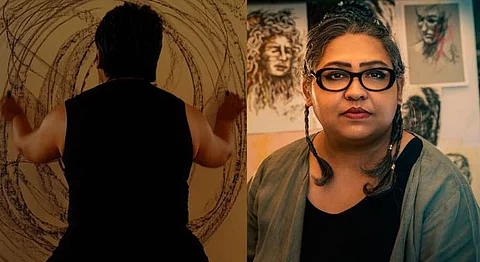
- HOMEGROWN WORLD
- #HGCREATORS
- #HGEXPLORE
- #HGVOICES
- #HGSHOP
- CAREERS
- ABOUT US
- CONTACT US

If we even extend a cursory look at art history, it seems almost blatantly visible how most female depictions function from a ubiquitous male perspective. It’s a perspective where women are often posing in demure passive states and are non-confrontational to the audience and the painter (mostly a man) disarming her of agency and putting himself in a power position.
It can’t be denied that most arts and films have always featured women from a man’s voyeurist gaze; one that capitalizes on beauty as a currency. In such a climate, what embodies the female gaze? Is it just a term that will be lost in translation and most importantly are all female artists automatically operating from a female gaze?
The female gaze is far more nuanced than most may believe, it stems from an empathetic understanding of agency and of depicting both external and internal emotional depictions. Where women’s primary objective isn’t to be consumed, where they aren’t passive objects who are neither dynamic nor active.
In this context, artist Nivedita Saha’s extensive practice that spans different methodologies and forms, from print-making to site-specific practices functions from a largely feminist gaze. Saha explores art through multiple channels of thought, storytelling, philosophy and sociopolitical exigencies. Her work has a zeitgeistic promise as she works around themes of the feminine divine, mythology, and the female gaze - with a focus on Indian iconography.
Her work - Kali’s Dream is a performance of the artist’s body, with its restrictions and limitations, intimacy, and private womb-like existence. Through this process of art-making, the artist metaphorically explores her personal history juxtaposed with mythological layers and engages the viewer in an unknown time in order to highlight the fragility of womanhood and the sensitivity of the mind and spirit.
The project obsessively addresses fraught circumstances through force and form through a poetic sensibility that balances the gravitas of the subject. Her work derives its inspiration from a powerful Hindu Goddess Kali (Sanskrit word Kal) means time. A deity also known as the Dark Mother, she is the goddess of creation, preservation, and destruction.
The artists’ body engages not only in a mythological reality but also the present global issues thus attaching herself to the work until she becomes the work herself. The artist parallels a vessel, starts empty, and ends empty.
By harnessing her interest in old traditions and exploring new ones by creating an honest interactive space for dialogue and reflection, her work intends to encourage culturally-distinct individuals to think. In contemporary feminist art, what we can understand through Saha’s work is that the concept of the female gaze is not just a reclamation of the female body but also the idea of its beauty. Its depiction isn’t limited to just this and extends well beyond; establishing a new form along with a new way of expression.
You can checkout the artist’s work here.
If you enjoyed reading this, we suggest you also read:
